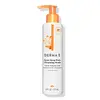What's inside
What's inside
 Key Ingredients
Key Ingredients

 Benefits
Benefits

 Concerns
Concerns

 Ingredients Side-by-side
Ingredients Side-by-side

Salicylic Acid 2%
MaskingWater
Skin ConditioningDisodium Laureth Sulfosuccinate
CleansingCocamidopropyl Hydroxysultaine
CleansingCocamidopropylamine Oxide
CleansingPEG-150 Distearate
EmulsifyingPolysorbate 20
EmulsifyingMelaleuca Alternifolia Leaf Oil
AntioxidantGlycerin
HumectantLavandula Angustifolia Oil
MaskingAniba Rosodora Wood Oil
AstringentSalix Alba Bark Extract
AstringentChamomilla Recutita Flower Extract
MaskingDecyl Glucoside
CleansingPotassium Sorbate
PreservativePhenoxyethanol
PreservativeEthylhexylglycerin
Skin ConditioningSalicylic Acid 2%, Water, Disodium Laureth Sulfosuccinate, Cocamidopropyl Hydroxysultaine, Cocamidopropylamine Oxide, PEG-150 Distearate, Polysorbate 20, Melaleuca Alternifolia Leaf Oil, Glycerin, Lavandula Angustifolia Oil, Aniba Rosodora Wood Oil, Salix Alba Bark Extract, Chamomilla Recutita Flower Extract, Decyl Glucoside, Potassium Sorbate, Phenoxyethanol, Ethylhexylglycerin
Cocos Nucifera Oil
MaskingGlycerin
HumectantMelaleuca Alternifolia Leaf Oil
AntioxidantChamomilla Recutita Flower Extract
MaskingHydrastis Canadensis Root Extract
MaskingHedychium Coronarium Root Extract
MaskingFucus Vesiculosus Extract
EmollientCymbopogon Martini Oil
MaskingCitrus Aurantium Amara Peel Oil
Skin ConditioningLavandula Angustifolia Oil
MaskingChamomilla Recutita Flower Oil
MaskingCalendula Officinalis Flower Oil
MaskingCallitris Intratropica Wood Oil
MaskingCocos Nucifera Oil, Glycerin, Melaleuca Alternifolia Leaf Oil, Chamomilla Recutita Flower Extract, Hydrastis Canadensis Root Extract, Hedychium Coronarium Root Extract, Fucus Vesiculosus Extract, Cymbopogon Martini Oil, Citrus Aurantium Amara Peel Oil, Lavandula Angustifolia Oil, Chamomilla Recutita Flower Oil, Calendula Officinalis Flower Oil, Callitris Intratropica Wood Oil
Ingredients Explained
These ingredients are found in both products.
Ingredients higher up in an ingredient list are typically present in a larger amount.
Chamomilla Recutita Flower Extract comes from the Chamomile flower.
Chamomile is rich in antioxidants and has anti-inflammatory properties. Several compounds found in chamomile help with soothing, such as bisbolol.
Antioxidant components in chamomile make it an effective ingredient to help slow the signs of aging. Antioxidants help fight free-radical molecules, or molecules that may damage your skin.
Essential oils from chamomile have been found to improve wound healing due to its antimicrobial properties.
Ancient Greeks and Egyptians used Chamomile to treat skin redness and dryness. Chamomile has also been used to help treat stomach issues.
Learn more about Chamomilla Recutita Flower ExtractGlycerin is already naturally found in your skin. It helps moisturize and protect your skin.
A study from 2016 found glycerin to be more effective as a humectant than AHAs and hyaluronic acid.
As a humectant, it helps the skin stay hydrated by pulling moisture to your skin. The low molecular weight of glycerin allows it to pull moisture into the deeper layers of your skin.
Hydrated skin improves your skin barrier; Your skin barrier helps protect against irritants and bacteria.
Glycerin has also been found to have antimicrobial and antiviral properties. Due to these properties, glycerin is often used in wound and burn treatments.
In cosmetics, glycerin is usually derived from plants such as soybean or palm. However, it can also be sourced from animals, such as tallow or animal fat.
This ingredient is organic, colorless, odorless, and non-toxic.
Glycerin is the name for this ingredient in American English. British English uses Glycerol/Glycerine.
Learn more about GlycerinLavandula Angustifolia Oil is more commonly known as lavender essential oil. It is considered a fragrancing ingredient.
Lavender imparts a famous scent. While the smell is lovely, this ingredient and may sensitize skin in topical products. This is because about 85% of the oil is made up of linalool and linalyl acetate.
When exposed to air, these two compounds become strong allergens. This ingredient exhibits cytotoxicity at low concentrations; amounts of 0.25% have been shown to damage skin cells.
A study from Japan found this ingredient caused lavender sensitivity after widespread exposure.
Lavender essential oil has some antimicrobial, antibacterial, and anti-inflammatory properties. However, the cons of this ingredient may outweight the pros.
More research is needed to confirm lavender essential oil's effects when used in aromatherapy.
Lavandula Angustifolia is known as the English Lavender and famous for creating purple fields in Provence, France.
Learn more about Lavandula Angustifolia OilThis tea tree oil comes from the leaves of the Tea Tree plant. Tea tree oil has antioxidant, anti-inflammatory, and antimicrobial properties.
According to the book Journal of Profiles of Drug Substances, tea tree helps in reducing acne-causing bacteria such as Propionibacterium acnes. This is due to the Terpinen components of tea tree oil.
Tea tree may cause sensitivity and irritation for some people. This oil naturally contains fragrance such as linalool and limonene.
However, research shows irritation usually occurs when using pure tea tree oil and not in cosmetic products.
Tea tree oil was found to help relieve the symptoms of psoriasis in one study.
Tea tree oil is toxic when ingested. Another study showed it to caused damage to the nervous system of dogs and cats when applied to their skin or given orally.
Learn more about Melaleuca Alternifolia Leaf Oil